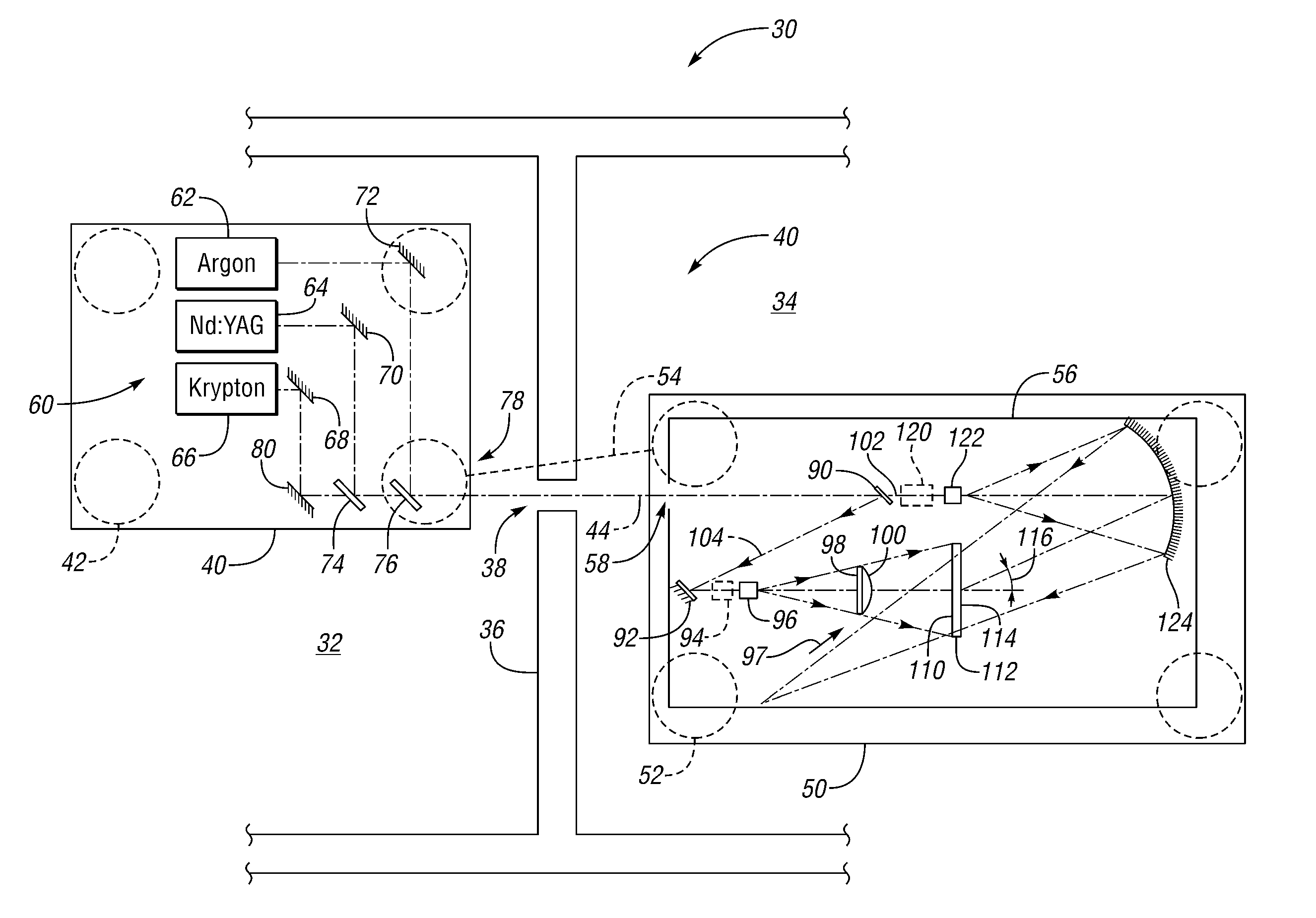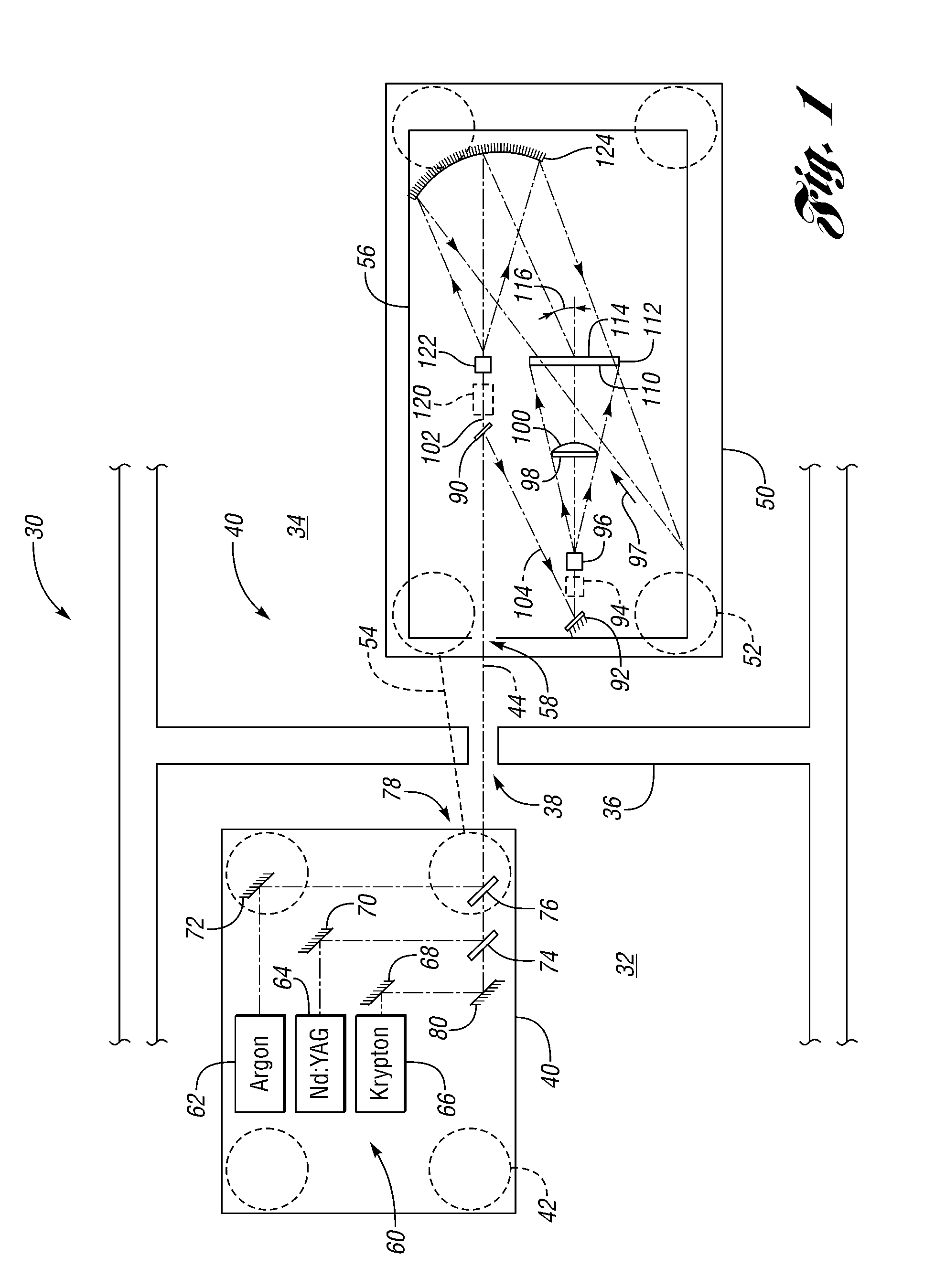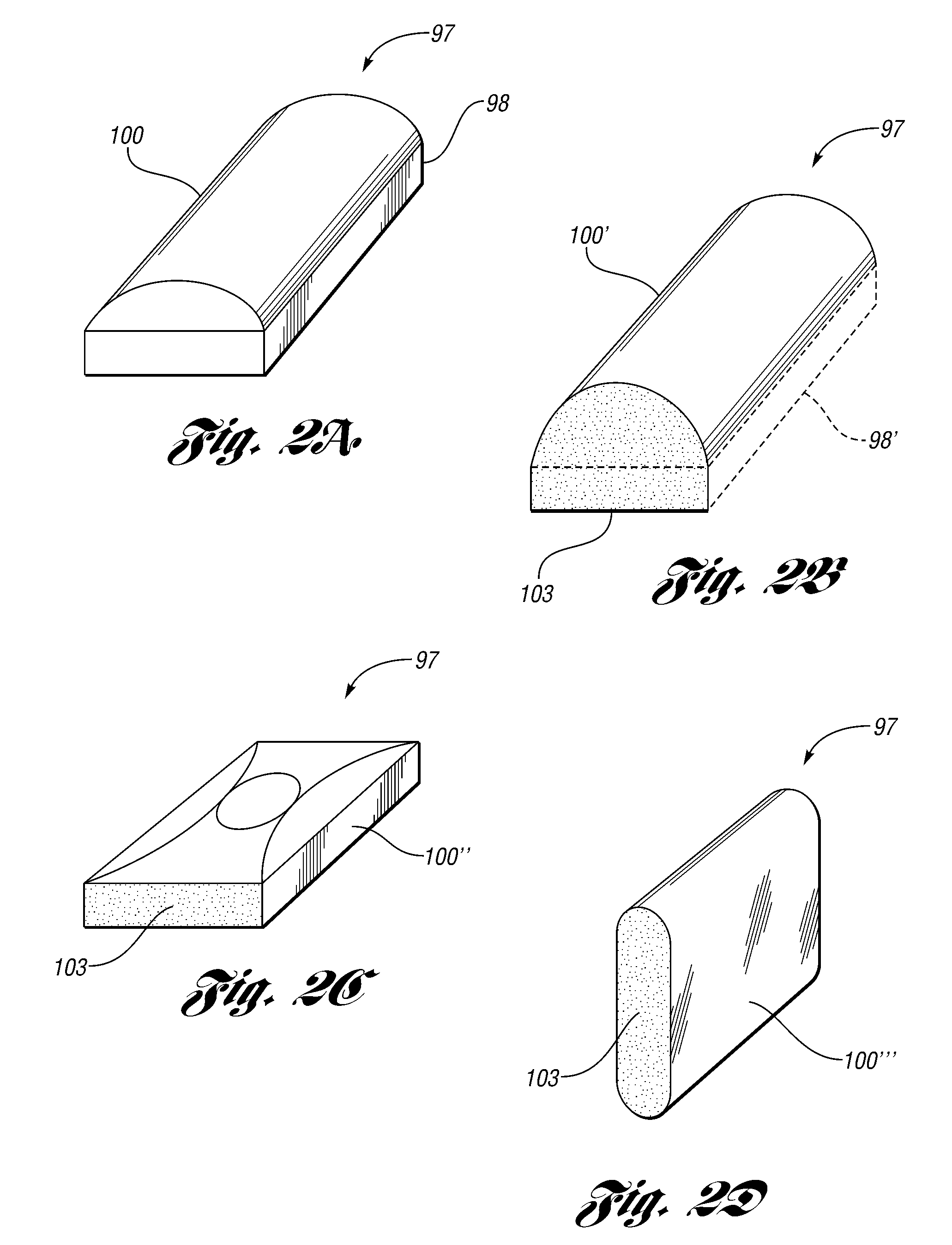[0015]Systems and methods for creating an autostereoscopic three-dimensionally perceived image unaided by glasses or headgear include embodiments having a
holographic optical element (HOE) recorded using coherent light of at least three wavelengths divided into a diverging
reference beam and a diverging object beam that illuminate the HOE from opposite sides, the object beam passing through first and second diffusers with one diffuser being a directional diffuser to more uniformly illuminate the HOE during
exposure. Various embodiments include one or more optic elements, such as a lens or telecentric
beam expander(s), associated with a coherent source for at least one of the wavelengths to more closely match beam diameters of the at least three wavelengths. Similarly, anamorphic
optics, such as an anamorphic
prism pair, may be used for one or more light sources to better match beam profiles of the at least three wavelengths. In one embodiment, fixed optical baffles are positioned on opposite sides of the HOE with openings aligned
proximate the
reference beam and object beam paths, respectively, to reduce stray reflections and provide
ambient air flow attenuation or damping. One or more edges of the HOE are masked to reduce or prevent
stray light from entering and reflecting within the HOE during recording.
[0016]Various embodiments include a directional diffuser or
homogenizer, which may have a desired eye box geometry, to improve transmission efficiency of the object beam. The directional diffuser may be implemented by a holographic element to transform an input beam having a
Gaussian or other non-uniform intensity profile to more uniformly illuminate the HOE during the
exposure period. The directional diffuser may have an illumination profile to improve conformance or mapping of the object beam to the
aspect ratio of the HOE. The directional diffuser may be used in combination with a
beam expander, implemented by an elongated
cylindrical lens in one embodiment, and a second diffuser, implemented by a
ground glass plate in one embodiment, positioned between the
beam splitter and the HOE to provide more uniform illumination of the HOE by the object beam.
[0018]Systems and methods for generating an autostereoscopic image include at least one
projector having at least one
light source with wavelengths substantially matched to the recording wavelengths of the HOE. In one embodiment, a stereo
projector includes dual output lenses having central axes separated by a distance corresponding to a desired average intra-
pupillary distance (multiplied by the ratio of the
projector-screen / screen-viewer distance) of intended viewers. The stereo projector illumination sources are powered by a common power supply with passive
convective cooling so that no cooling fan or other
forced air cooling is required. In another embodiment, two substantially identical projectors are used. Projectors may include LED sources having peak wavelengths closely aligned or matched with the
laser wavelengths used during recording of the HOE. In some embodiments, passbands of the HOE are modified by
emulsion shrinkage. In one embodiment having recording wavelengths of 647 nm, 532 nm, and 476 nm, an LED projector includes closely aligned or substantially matched wavelengths of 637 nm, 518 nm, and 462 nm. Embodiments include projectors having optical keystone correction provided by a telecentric
image plane projection lens system that may be supplemented with digital keystone, gamma, and / or other corrections provided by
integrated electronics or an
external image processing card, box, or similar device. The systems and methods according to various embodiments of the present disclosure project first and second substantially overlapping images onto a reflection HOE having a holographically recorded interference pattern captured within a single layer panchromatic photosensitive material during recording with at least one
beam shaping device positioned in a reference beam and / or object beam path to improve uniformity of illumination and reduce or eliminate
vignetting. The interference pattern captured in the
photographic emulsion is produced by interference between mutually coherent object and reference beams of at least three lasers having wavelengths substantially corresponding to the illumination source of the at least one projector. The HOE illuminated by object and reference beams incident from opposite sides is then processed or developed and sealed to produces a reflection HOE screen illuminated from the viewing side by the at least one projector during use.
[0024]Embodiments according to the present disclosure have various associated advantages. For example, embodiments that use a diverging reference and object beam eliminate the need for a spherical or parabolic concave minor to illuminate the HOE during recording. Matching of beam waists and / or profiles of two or more coherent sources improves the
system efficiency and may improve uniformity of illumination and
color balance across the HOE for better color fidelity during playback. Masking of the edges of the HOE during recording reduces or eliminates artifacts associated with
total internal reflection (TIR) of
stray light entering the substrate during recording. Similarly, appropriately positioned baffles provide air damping and block stray reflections or other light during recording of the HOE. Use of an aperture in combination with a
cylindrical lens and directional diffuser improves efficiency with better mapping of the object eyebox to the
aspect ratio of the HOE.
[0025]Embodiments of the present disclosure provide real-time stereo images to corresponding eyes of at least one viewer to produce a three-dimensionally perceived image without viewing aids, such as glasses or headgear. Various embodiments according to the present disclosure provide real-time viewer position detection and
image display synchronization to allow the viewer to move while staying within predetermined eye-boxes so that
perception of the three-dimensional image is unaffected by viewer movement. Use of a reflection holographic element provides higher resolution and improves color fidelity of reflected images, both of which are desirable for a number of applications, such as
medical imaging,
video gaming, and personal entertainment devices, for example. Use of a
beam shaping device in at least one of the reference and object beam paths during recording of a holographic optical element according to various embodiments of the present disclosure provides more uniform illumination to reduce or eliminate
vignetting. Use of a directional diffuser rather than a
ground glass plate or apodizer provides significant improvements in object beam efficiency.
 Login to View More
Login to View More  Login to View More
Login to View More 


